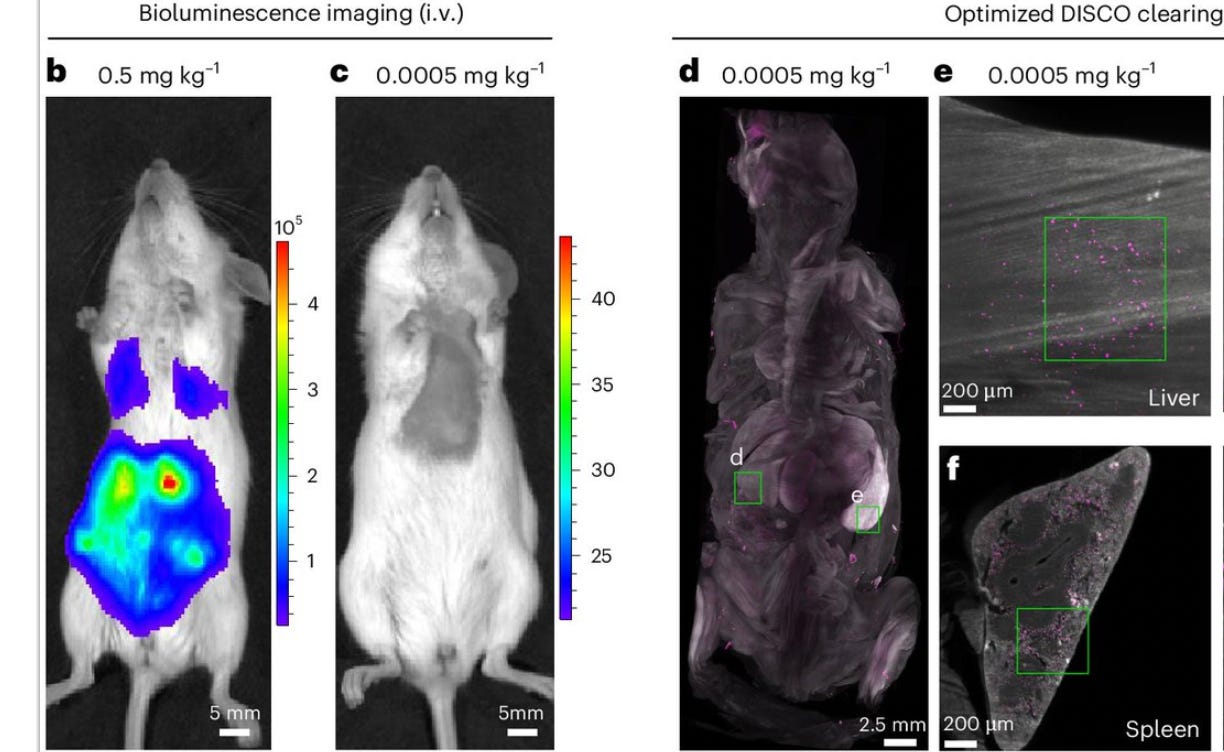In the post-pandemic period, there were two particularly appalling and incontrovertible studies about the mRNA jabs that more than anything else started the slow reversal of science’s great stampede toward genetic therapies. The first was actually a group of studies, led by Kevin McKernan, confirming the shots were contaminated with DNA fragments of bacteria normally found in human waste. (Literally, “s— shots.”) The second was a gold-standard study finding “frame-shifting” (mutational drifts) in the induced spike proteins. Yesterday we received a third seminal study to help sink the shots and the Frankenstein’s nightmare called mRNA technology.

The peer-reviewed study published yesterday in the prestigious Nature Biotechology, titled “Nanocarrier imaging at single-cell resolution across entire mouse bodies with deep learning.” It had forty authors. There’s safety in numbers. They cautiously avoided criticizing the covid shots directly, but the implications were unavoidable.
This study investigated lipid nanoparticles (LNPs), which are the tiny globs of fake fat that deliver mRNA into cells. They tracked the LNPs’ distribution and effects throughout the body—which they found far beyond the injection site. The researchers found that even at very low doses, LNPs wander far afield and worse, they accumulate in unintended organs, triggering immune disregulation and metabolic disturbances.
The study’s carefully documented conclusion upended the government’s original claims the mRNA vaccines would remain “localized at the injection site” (i.e. that they’d quickly and harmlessly dissolve in your shoulder). The findings also provided a plausible explanation for what causes serious known side effects like myocarditis.
These findings aren’t altogether new. They align with earlier findings from a widely ignored 2022 Japanese biodistribution study. The difference now, though, is these scientists used cutting-edge imaging technology to track LNPs in mice, and they used A.I. to analyze very complex data sets (such as systemic effects with multiple variables) and for modeling simulations at various LNP dosages.
There are several levels here. Superficially, the FDA should urgently re-examine the biodistribution issue and immediately require the shotmakers to confirm these findings and study the long-term effects and implications. Of course, we all know the benighted FDA will do nothing of the kind, at least not for five more days.
Next, and more significantly, the study further undermined the foundations not just of the covid shots, but of mRNA technology writ large. This week, Moderna —a pharma firm that only develops mRNA drugs— lost a fifth of its stock value on news of actual sales far below original, conservative projections.
But now we also know that Moderna’s stock plunge preceded the publication of this new biodistribution study by a single day. That timing was probably not coincidental.
The study’s findings reveal the third structural problem with mRNA. Until those structural problems are solved, or even addressed, mRNA risks becoming nothing more than a forgettable footnote in the sordid history of scientific failure: a tragic tale of overpromised innovation and blind faith in cutting-edge technology, calamitously unraveled by unmet safety and efficacy standards.
And that is assuming things don’t get any worse. Which is the point—we don’t know. This study provided no reassurances. And it probably poisons all mRNA projects.
Take, for instance, the long-promised vision of using mRNA to deliver customized cancer cures. The concept involves encoding the mRNA with some protein from your specific cancer, in theory prompting the body to mount a targeted immune response. But so long as the treatment relies on lipid nanoparticles (LNPs) to deliver its mRNA payload, this study suggests a potentially catastrophic risk: the cancer protein could unintentionally transfect major off-target organs like the heart, liver, kidneys, and spleen, potentially spreading cancerous material throughout the body while simultaneously disrupting the immune system.
Needless to say, that would be a bad combination. Unless we are missing something, the future of targeted mRNA cancer treatments does not look bright. As for respiratory viruses, that ship has already sailed.
The truth continues to dribble out. This study presented an unavoidable obstacle to all future mRNA development, a new reveal that joins and combines with the first two major revelations. This most terrible idea of mRNA is not yet dead, not quite, but all of mRNA’s major organ systems have been infected, and it’s been moved to hospice, leaving its loudest proponents languishing in the denial stage of grief.
This study is extraordinary progress. It really does seem like everything sad is coming untrue, slowly perhaps, maybe bit by bit, but it is happening.
http://publication_id=463409&post_id=154888913&triggerShare=true&isFreemail=true&r=yh8aw&triedRedirect=true






